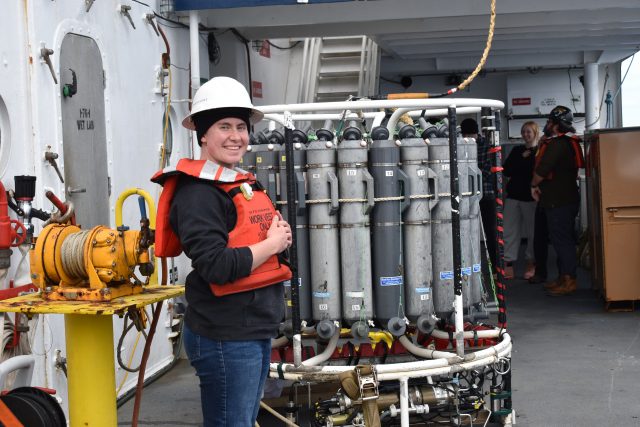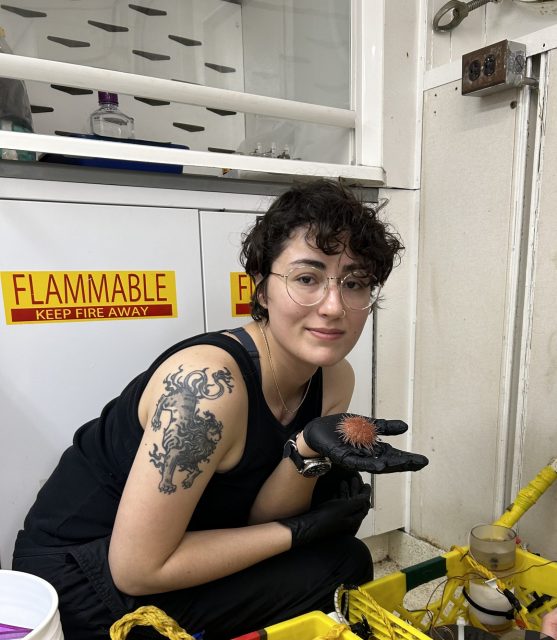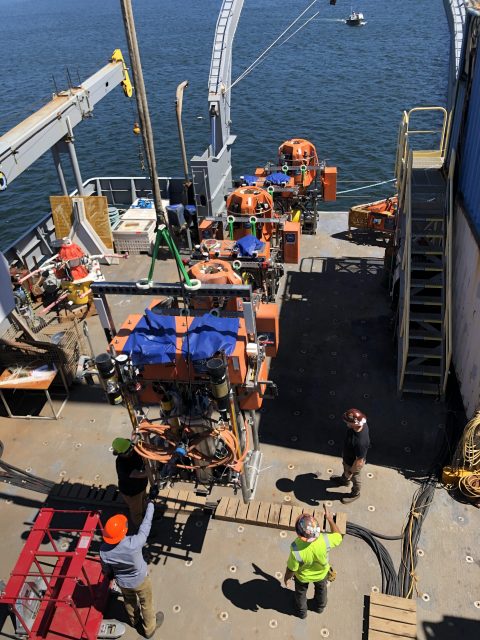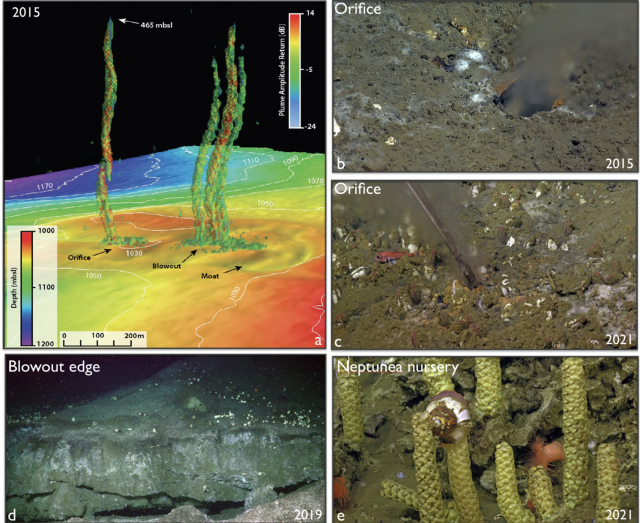Posts Tagged ‘Regional Cable Array’
Life at Sea: Student Reflections from the VISIONS’24 (Leg 3) Expedition
As part of the Regional Cabled Array operations and maintenance 2024 cruise, a cohort of 24 undergraduates spanning different countries of origin, states, and socio-economic backgrounds, participated in the expedition as part of the UW at-sea experiential learning program called VISIONS. This program has allowed over 200 undergraduate students, studying myriad disciplines, the opportunity to spend 8-45 days at sea on NSF-funded global class research ships utilizing state-of-the art remotely operated vehicles (ROV). Onboard, they stand 4-hr on, 8-hr off watches in the ROV control room working alongside the pilots, and RCA engineers and scientists. They work out on deck, learn about ship operations, and gain skills in oceanographic sampling and analyses of fluids. They see first-hand life forms rarely seen thriving in some of the most biologically productive waters in the ocean along the Cascadia Margin, the abyss at 2900 m water depth, and on 350°C underwater hot springs at the summit of Axial Seamount – the most active underwater volcano off the Oregon coast. The interviews below provide a glimpse of VISIONS’24 student impressions of life at sea and their experiences onboard. For many, their lives are forever changed.
Among the 2024 cohort was Morrigan Havely, whose curiosity and eagerness to explore marine science drove them to join the VISIONS program. Their journey aboard the R/V Atlantis highlights the combination of technical skill-building and personal development that the program supports. Morrigan’s experience reflects the unique community and collaborative spirit found at sea, where learning extends beyond science to include teamwork, resilience, and adaptability.
What motivated you to join the VISIONS program?
An oceanography undergraduate praised his experience with the program the year prior and highly recommended I join. One of my biggest goals with becoming a marine science major was to travel, and after reading about the amazing experiences of past students via their blogs, I knew that I wanted to sail aboard the R/V Atlantis.
What skills did you develop or strengthen during your time at sea that you feel will be valuable in your future career?
Time at sea in general is a super valuable experience, because it’s an entirely different culture than on land. You learn to work with people in extremely close quarters at all hours of the day, even if that means getting up at two in the morning to log Jason events. Learning about ship culture and having an on-board experience was an integral part of VISIONS ‘24.
How do you see the skills and experiences gained from the seagoing and Ocean 411 class, contributing to your role in the future workforce, particularly in science and engineering fields?
Research is a huge part of the marine science field, and Deb made sure to emphasize the importance of integrating our findings with education. VISIONS takes a risk by sending inexperienced undergraduates out on a global class research ship conducting industrial-style operations to learn necessary skills, and I think it’s important to recognize and pay that opportunity forward through sharing what we find aboard with the community.
What advice would you give to other students considering applying for experiential learning programs like VISIONS?
Show your enthusiasm for the program! Enthusiasm is a product of a willingness to learn and a desire to be present, and those are the two most important qualities I’ve seen past VISIONS students exhibit. Even if you don’t have experience on boats or doing research, show in your application that you’re willing to stay up for odd hours to watch hydrothermal vent fields in real time and learn lab skills off-shift. Enthusiasm will make up for lack of experience.
What was the most surprising thing you experienced during your time at sea?
How kind and willing everyone was to teach me. Even outside of the science team, we had crew members showing us how to tie knots and work with the equipment on deck. We cracked jokes with the Jason team members in the control van and ate with the mates in the galley. The community created on a ship extends outside of scientists, and I’m so glad I got to be a part of that camaraderie.
[caption id="attachment_35516" align="alignnone" width="640"]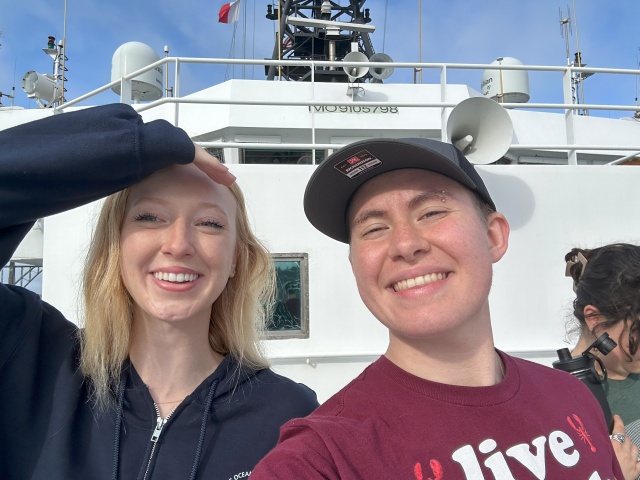 Morrigan (R) and team member onboard R/V Atlantis (Leg 2)[/caption]
[caption id="attachment_35517" align="alignnone" width="640"]
Morrigan (R) and team member onboard R/V Atlantis (Leg 2)[/caption]
[caption id="attachment_35517" align="alignnone" width="640"]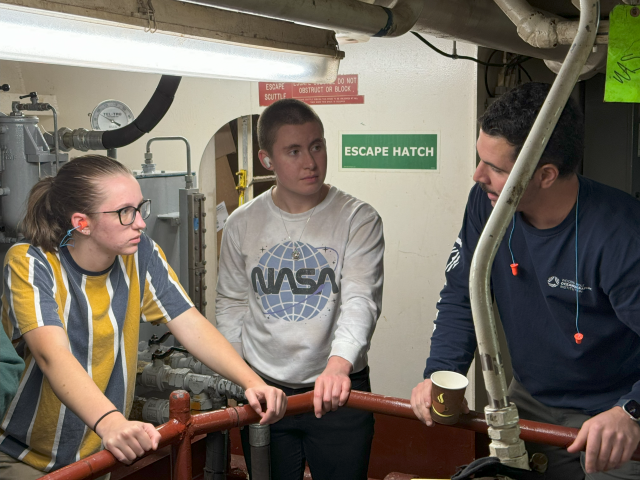 Teammates interact during VISIONS 24 cruise.[/caption]
Read More
Teammates interact during VISIONS 24 cruise.[/caption]
Read More Life at Sea: Student Reflections from the VISIONS’24 (Leg 2) Expedition
As part of the Regional Cabled Array operations and maintenance 2024 cruise, a cohort of 24 undergraduates spanning different countries of origin, states, and socio-economic backgrounds, participated in the expedition as part of the UW at-sea experiential learning program called VISIONS. This program has allowed over 200 undergraduate students, studying myriad disciplines, the opportunity to spend 8-45 days at sea on NSF-funded global class research ships utilizing state-of-the art remotely operated vehicles (ROV). Onboard, they stand 4-hr on, 8-hr off watches in the ROV control room working alongside the pilots, and RCA engineers and scientists. They work out on deck, learn about ship operations, and gain skills in oceanographic sampling and analyses of fluids. They see first-hand life forms rarely seen thriving in some of the most biologically productive waters in the ocean along the Cascadia Margin, the abyss at 2900 m water depth, and on 350°C underwater hot springs at the summit of Axial Seamount – the most active underwater volcano off the Oregon coast. The interviews below provide a glimpse of VISIONS’24 student impressions of life at sea and their experiences onboard. For many, their lives are forever changed.
The cohort included students like Leo Couchon, whose passion for ocean sciences and hands-on learning brought a unique perspective to the expedition. Leo embraced the challenges and opportunities of life at sea, immersing themselves in the demanding yet rewarding work environment. Their reflections offer a window into how the VISIONS program not only provides technical skills but also fosters personal growth and a deeper connection to the oceanographic community.
What motivated you to join the VISIONS program?
I really look up to Deb as a pioneer in Ocean Sciences and was really excited about the opportunity of learning about all different types of life on a research vessel. I wanted more than anything in the world to get my sea legs. It’s difficult to get your first experience at sea/days at sea, but it’s vital for oceanographic and marine technician work.
What skills did you develop or strengthen during your time at sea that you feel will be valuable in your future career?
Over the course of the VISIONS program, I had numerous opportunities to learn new skills and techniques. I learned how to perform meticulous, detail-oriented data logging in the ROV control van, how to deploy a CTD with Niskin bottles, and sediment push core sampling techniques. In some cases, the actual skills I was learning were second to who I was learning it from. I got the chance to learn about microbial mats and sediment cores directly from Dr. Laura Lapham, and I had the opportunity to learn Oceanographic field techniques from the people who developed the equipment we were using! I also feel like I learned things that helped me develop my communication skills in this kind of unique work environment. Between the strenuous work schedule and the round-the-clock nature of the crew and science team’s activities, I began to realize how interdependent and involved different departments need to be. Being able to effectively communicate within this was so important to my takeaway from this experience – everyone has something important to offer in terms of insight, even other students, and being able to navigate that interdependence and make a point to talk to everybody on the boat did a lot to enrich my experience.
How do you see the skills and experiences gained from the seagoing and Ocean 411 class, contributing to your role in the future workforce, particularly in science and engineering fields?
It was inspiring to be surrounded by professionals in the field I want to spend my life in; having that sense of responsibility and dedication is intoxicating. It’s something that I’ll bring with me to every future position I hold. I want to do meaningful science that involves the communities that I work within, and I want to learn enough that I can teach people. I loved being connected to everyone on the boat, getting to hear people’s stories and personal connections are important for science communication. There are still so many people out there that don’t even know what oceanography is as a field let alone how all of the pieces of the puzzle fit together. I am so genuinely excited to share my experience with anyone that will listen. I think that the skills I learned during VISIONS will be incredibly important to my future career in research, but moreover I believe that this experience increased my capacity to be effective in science communication.
What advice would you give to other students considering applying for experiential learning programs like VISIONS?
You can only get as much from the program as you put in, so apply yourself to everything that comes your way because you’ll never know what you can get from it. It’s difficult to put yourself out there but it’s worth it. Saying yes to everything that comes your way and always being willing to help everyone during the program is vital in learning a variety of skills. That said I also recommend advocating for your needs and ensuring you not to overload yourself. Carving out time for yourself to rest, reflect, and enjoy the experience for what it is can be equally important.
What was the most surprising thing you experienced during your time at sea?
There are so many people on the boat in one space and everyone is working 24/7, there’s always someone in the middle of their sleep while someone is in the middle of their shift and there is always something to learn – but it’s also routine. You just melt into the way that the boat operates. It’s the little moments that would catch me off guard. There was a night at around 2am where I left the darkness of the control van lit only by the ROV’s camera at around 2000 meters deep to be met with the expanse of the sky reflecting the end of the Perseids meteor shower. Or a day when I fully bawled on deck after everyone rushed out to see a dolphin pod following and I caught a glimpse of my favorite fish that I never thought I would get to see in person, the Mola mola. There is a sense of magic that’s difficult to put into words. You can’t ever quite carve out a moment of silence or time alone but you’re experiencing everything aboard with everyone. It’s both connecting and isolating all at once, the things that make it difficult are the very same things that make it beautiful.
[caption id="attachment_35504" align="alignnone" width="640"]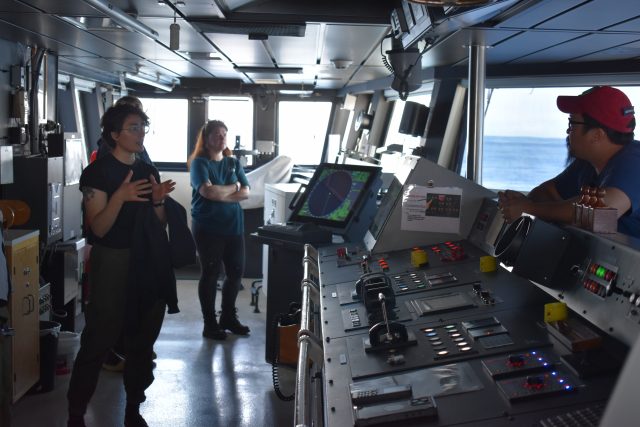 Bridge tour. (c) Kellen Rosburg[/caption]
[caption id="attachment_35503" align="alignnone" width="640"]
Bridge tour. (c) Kellen Rosburg[/caption]
[caption id="attachment_35503" align="alignnone" width="640"]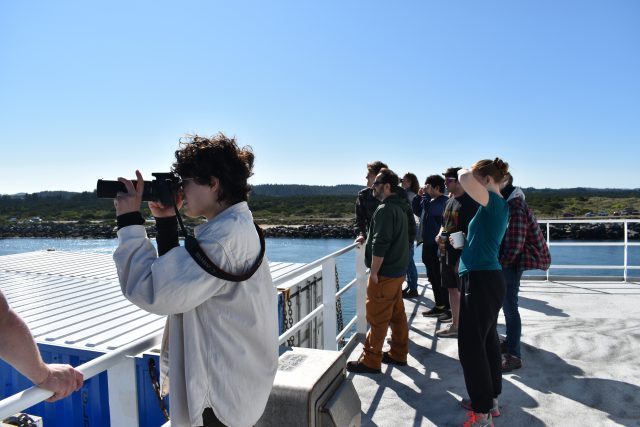 End of Leg 2. (c) Mitch Elend[/caption]
[caption id="attachment_35506" align="alignnone" width="640"]
End of Leg 2. (c) Mitch Elend[/caption]
[caption id="attachment_35506" align="alignnone" width="640"]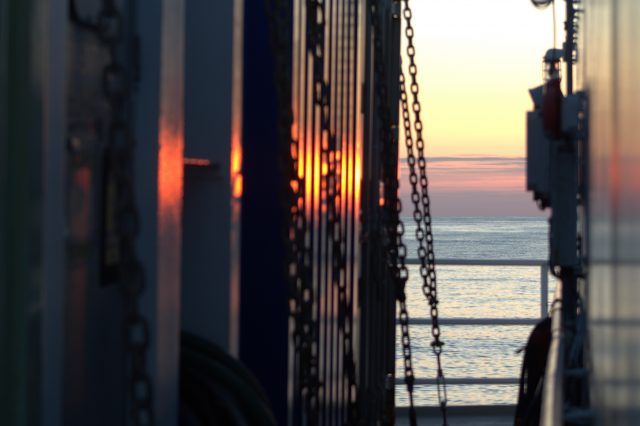 Sunrise on deck. (c) Leo Couchon[/caption]
Read More
Sunrise on deck. (c) Leo Couchon[/caption]
Read More RCA Embarks on a 41-day Operations and Maintenance Expedition
Watch live video here.
The numbers are remarkable for the Regional Cabled Array’s (RCA) Operations and Maintenance Expedition that left Newport, Oregon aboard the R/V Thomas G. Thompson on Sunday August 13. Because of its complexity and the need to move 100 different instruments, the expedition consists of four legs over 41-days. The legs are separated by ~2-3 days port call at NOAA Marine Operation Center in Newport, Oregon. A science team of 12 is conducting the scientific operations, with their work supported by an engineering team of 20 (not all onboard). The Remotely Operated Vehicle (ROV) Jason, operated by a team of 12 from the Woods Hole Oceanographic Institution, is recovering and deploying instrumentation on the RCA for the duration of the expedition.
Finally, 25 students in the University of Washington’s VISIONS Program are onboard during various legs to gain real sea-going experience and work side by side with the scientific team. Additionally, six other guest participants will be onboard, including a children’s author, engineers, and scientists.
The RCA annual expedition is always an exciting opportunity to watch real-life operations at sea. Operations will be live-streamed here. Details about the expedition, who’s involved, and what’s happening and planned can be found here. Daily updates can be found here.
[video width="608" height="1080" mp4="https://oceanobservatories.org/wp-content/uploads/2023/08/Thompson-loading.mp4"][/video] Read MorePythias Oasis: The First-of-Its-Kind Seep in the Oceans
Adapted and condensed by OOI from Philip, et al., 2023, doi: 10.1126/sciadv.add6688.
[media-caption path="/wp-content/uploads/2023/01/Screen-Shot-2023-01-26-at-10.21.55-AM.png" link="#"] a) A multibeam sonar image of the methane bubble plumes at Pythias Oasis in 2015. b) Pythias orifice in 2015 showing the fluid-dominated, sediment-rich plume, as first visualized on the discovery dive by the ROV ROPOS. The main orifice has been continuously active since 2015. c) Pythias’ orifice in 2021 with increased biological communities and a small Fe-rich chimney. d) The edge of a large collapse-blowout zone – coring across this area in 2019 recovered substantial methane hydrate. e) A Neptunea snail nursery between the orifice site and the blowout zone.[/media-caption]Pythias Oasis is the first-of-its-kind seep in the oceans, providing a window into controls on megathrust events along the Cascadia Margin. Pythias Oasis, discovered during the 2015 Regional Cabled Array (RCA) Operations and Maintenance Cruise, utilizing the hull-mounted sonar on the R/V Thompson, is unlike any seep site yet described along active margins with unprecedented fluid chemistries (Figure above). It hosts an intense fluid-dominated venting system issuing low-salinity, hydrocarbon-bearing fluids carrying low concentrations of suspended particles from a discrete orifice that has been continuously active since 2015. Detailed sampling, as part of an NSF OCE-funded expedition in 2019 (OCE 16582901), and another dive in 2021 (added onto the RCA 2021 cruise) show that the fresh, warm fluids (four times background temperatures) are venting at the highest discharge rates yet measured within the Cascadia Subduction Zone (CSZ) and that the fluids are extremely enriched in boron lithium and iron.
Pythias Oasis provides a rare window into processes acting deep in the margin with fluid chemistries indicating that the fluids are sourced near the plate boundary in the Central CSZ at minimum temperatures of 150-250°C. The high discharge rates are thought to reflect draining of fluids along an over-pressurized reservoir associated with the subduction zone-perpendicular Alvin Canyon strike slip fault, suggesting that the faults regulate pore fluid pressure and megathrust slip behavior along the Central CSZ.
Results from this work are presented in Philip, B.T., E.A. Solomon, D.S. Kelley, A.M. Tréhu, T.L. Whorley, E. Roland, M. Tominaga, and R.W. Collier (2023) Fluid sources and overpressures within the central Cascadia Subduction Zone revealed by a warm, high-flux seafloor seep. Science Advances (9), doi: 10.1126/sciadv.add6688.
Read More
